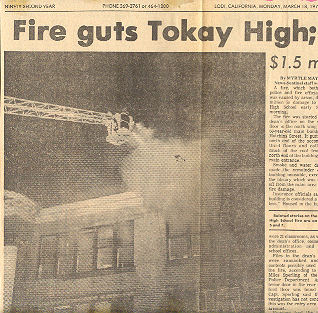
Growing up in Lodi, it was a rite of passage to which we aspired. Even today, 35 years after the dark morning that changed forever the landscape and future of our “little village,” there is a line of demarcation between us: There are those of us who attended “the old campus,” as it was lovingly known. And those who didn’t. Those of us who were fortunate enough to spend our high school years there have a kinship, a bond with which those who never had the opportunity cannot relate.
And even now, it is difficult to look at the images of our once-beautiful, stately campus in the process of being ravaged by a fire cruelly set by our own classmates. Judases they were, who knew that they would not graduate in the Lodi Grape Bowl — another tradition that today stands threatened as the structure ages badly and repair cost estimates create strife and dissension among residents. They would not march from the east onto the football field to the strains of “Pomp and Circumstance” played by the school band, led by a gaggle of “flower girls,” members of the junior class whose hoop skirts swayed from side to side as they carried six or eight floral bouquets to be delivered to the senior girls. They knew that their names would not be called to come forward and collect diplomas, so they would not hear the screams from the stands of their proud families and friends. They were painfully aware that, unlike the rest of us, they would not be attending the traditional “All Night Party” in the American Legion building just down the street.
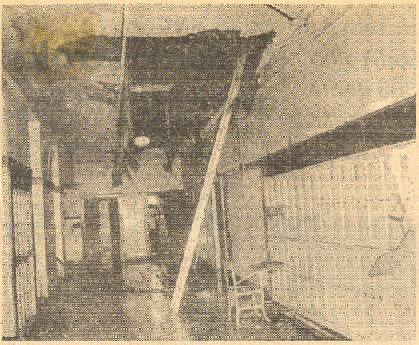
So on that March 15, 1974, Friday morning, as we sat in our third period Government class, waiting for the bell to ring and Mr. Berkowitz to wish us a relaxing weekend, they flicked Bic lighters and taunted each other. “Let’s burn the school down,” one said to the other as I rolled my eyes in disgust and looked up at the clock. After all, those two underachievers had been my classmates since fourth grade and among all the people I would miss after graduating, they were not included.
I had no way of knowing, of course, that in a little less than 48 hours, they would make good on their threat.
That 1974 St. Patrick’s Day was a quiet Sunday morning. Until my father came into the house looking for me, that is. “Kirk just stopped by. He said the school burned down.” I didn’t even respond. Grabbing whatever clothing I could find, I jumped on my 10-speed and pedaled the three blocks, fearing the worst, but ready, as a member of the Tokay Press staff, to cover whatever story awaited me.
I stumbled into the courtyard and joined a crowd of Lodians already assembled there, staring in disbelief at the Main Building from behind the yellow tape near the entrance to the Boys’ Gym. They were numb, some crying and pointing, whispering among themselves as they watched members of the Lodi Fire Department cleaning up.
One face stood out in the crowd: Guy P. Wakefield, a legend in Lodi and 1934 alumnus. He returned home after World War II to teach United States history to generations of Lodi teenagers in Room 20 on the second floor of the Main Building next to the Dean’s Office. It was in that office that the attendance records my classmates sought to destroy were stored. I will never forget the look on Mr. Wakefield’s face as he gazed up at the corner of the building to the classroom where he had spent his professional life, wiping away tears. It was destroyed. Obliterated. The caved-in ceiling was visible, dangling amid the colorful green St. Patrick’s Day decorations that swayed gently — and, it seemed to me, cruelly — as a breeze wafted into the room through the blown-out windows. Mr. Wakefield had lovingly adorned the room for his students, just as he had for every holiday for so many years. On Friday afternoon, he had passed candy out just before the dismissal bell rang, just as he had nearly every Friday, as he said good-bye, formally addressing his students as “Mr.” or, as in my case, “Miss Hickok.”
The next morning, the Lodi News-Sentinel described it this way:
The fire was started in the dean’s office on the second floor in the north wing of the 60-year-old main building on Hutchins Street. It gutted the north end of the second and third floors and collapsed much of the roof from the north end of the building to the main entrance.
Smoke and water damage made the remainder of the building unusable, except for the library which was sealed off from the main area of the fire damage.
Insurance officials said the building is considered a “total loss.” Housed in the building were 21 classrooms, as well as the dean’s office, counseling, administration, and adult school offices.
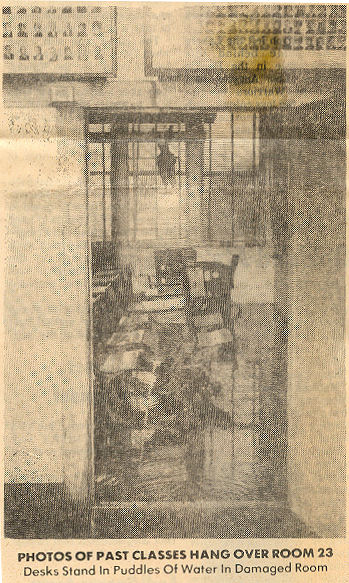
Also housed in that building were the memories and traditions that are inevitably amassed when students inhabit a school for 60 years. Above the moldings hung huge photo frames from which smiled the faces of every member of every graduating class since Lodi Union High School was established. We used to stand in the hallways waiting for our teachers to arrive, gazing up at those faces, marveling at the way their numbers grew over the years. They were a history lesson encapsulated in glass, encased in silent testament to the styles of the day and the lives of those who had walked the halls before we arrived. We somberly noted the dearth of Japanese-American smiles for a few years in the 1940’s, and rejoiced that they soon reappeared and took their rightful place as representatives of Lodi’s large Japanese-American population and culture. We retraced the carvings on the old wooden desks in which we sat, wondering what became of the student who etched his or her initials there so many years before. We cherished the marble stairs that graced the main entrance, each step hollowed out in the middle from so many sets of feet running up and down them. We loved the creaking of the heavy wooden doors with glass windows in the middle as they slammed shut behind us and cursed the ancient lockers we were assigned that never seemed to open until we spun the combination at least three times and stopped precisely on the last number.
The Lodi Unified School District constructed a new high school campus in 1957, but decided that Lodi was not yet ready for two separate high schools. So freshmen and sophomores inhabited the “new campus,” dubbed the “West Campus” because of its location several blocks west of Lodi Union High School. The “old campus” was officially known as “East Campus.” The legend and lore was enhanced as students transitioned away from the nondescript “baby campus” with its flat roofs, ugly concrete hallways, and utter lack of architectural appeal to the alluring, sophisticated, history-rich world of upperclassmen. It was far more than geography. The old campus was a world away.
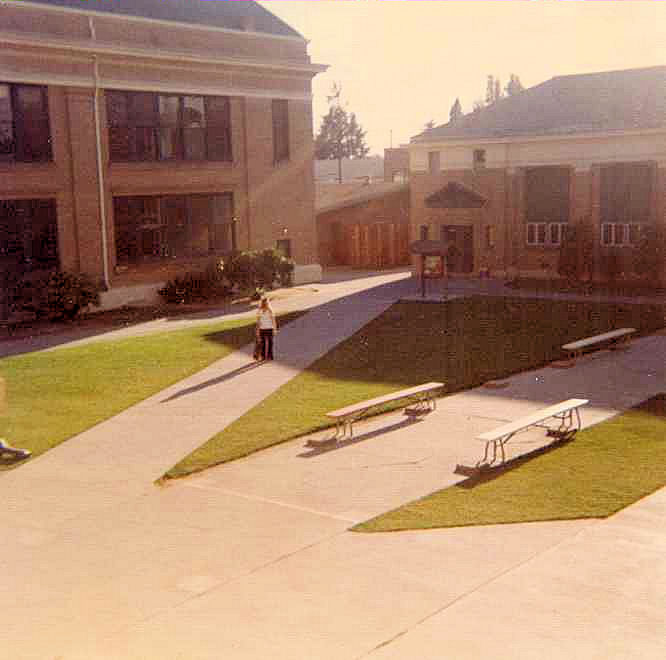
The rivalry between the inhabitants of the two campuses intensified when the school board decided that Lodi was finally ready to be home to two separate and distinct high schools. The West Campus remained Lodi High, but the East Campus became the city’s first Tokay High School, each a four-year campus. As Lodi High sophomores destined for Tokay High by virtue of the attendance boundaries devised, we voted not just on our new school’s name, but also its mascot (tiger), team name (Tokay Tigers), and colors (purple and gold), and learned a new alma mater composed by our choir director, Wylie Moffatt. We had the best of both worlds: A new identity filled with “firsts” being forged on an idyllic campus steeped in tradition and history. Lodi High kept all of the red and white band uniforms and choir blazers, and the school district, in a stunning display of shortsightedness, claimed there was no money to buy new uniforms or blazers for us. Our band marched proudly in the Grape Festival parade nonetheless, playing beautifully in their white t-shirts and blue jeans as we cheered them on from the sidewalk. In the spring, we were finally custom-fitted for our brand new uniforms and blazers.
And then suddenly, as the Lodi News-Sentinel observed, “the pride of Lodians for more than half a century [was] gone, destroyed by an arsonist. The stately white columns and massive front entry steps which could be seen when traveling west on Walnut Street still stood after yesterday’s fire, but behind the doors the classrooms were charred. When plans for the building were approved in 1912, it was termed ‘one of the finest school buildings in the state.’ A newspaper account said, ‘The front will center on Walnut Street, just south of Hutchins park. Looking down Walnut Street, it will be an imposing site.'” And it was.
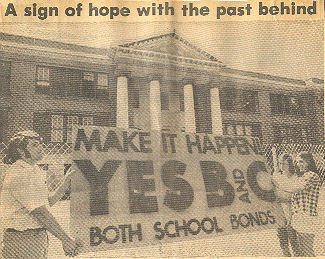 After the fire, Lodians came together to reach a previously unattainable goal: A successful bond election provided funding to at last complete Lodi High School and construct a new Tokay High School. That campus opened in 1977.
After the fire, Lodians came together to reach a previously unattainable goal: A successful bond election provided funding to at last complete Lodi High School and construct a new Tokay High School. That campus opened in 1977.
Thirty-five years later, Hutchins Street Square stands on the site of the “old campus.” Lodians were forced to bid farewell to the Main and Science Buildings, but thanks to a foundation established to salvage the remainder of the campus and establish a community center, the boys’ and girls’ gyms were renovated, along with the Auditorium. A wide variety of events and performances, including the Lodi Community Band’s concerts take place “on the square.”
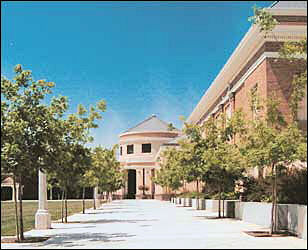
I never set foot on Hutchins Street Square without thinking about the happy hours I have spent there throughout my life. As a child, I took swimming lessons in the upstairs pool where I would, as a high school junior, earn my lifesaving certificate. In the old Tokay Press Room, under the leadership of Wayne Field, I discovered that I loved to write and began developing the confidence to do so. I played my clarinet as part of the summer band program in the old band room where I would later study music theory, be a member of the A Cappella Choir and Madrigal Singers, and return as an adult to finally achieve my lifelong dream of being a flutist. Every time I walk onto the stage in the now state-of-the-art auditorium, I remember the pep rallies, Junior Variety Shows, plays, concerts, and countless hours I spent rehearsing in that building before all of those activities were silenced by the flames. I chuckle when I recall how we never set foot in the balcony because you never knew when you might encounter a bat, even though Wylie instructed us to aim for the back wall of that balcony when projecting our voices on stage (we were not mic’d). We autographed the walls of the basement dressing room, staking, we thought, our claim for posterity. For instance, before they tore down those walls, you would have found my signature evidencing that I did in fact portray Veta Louise Simmons in the 1973 production of “Harvey.”
It is all part of the continuity and sense of community that keeps me anchored to the little village with which I have an ongoing love-hate relationship. It is a constant reminder that nothing remains the same and change is often unwelcome, disrupting our peaceful existence in violent fashion when we least expect it. But we survive and prosper, sometimes literally arising from ashes. Hutchins Street Square stands, just as the local newspaper declared back in 1974, as “a sign of hope with the past behind” it, reminding all of us who pass by and enter in that we craft our futures from our hopes, as our past provides the foundation that defines us and makes us strong.

10 Comments
Wow…that’s an incredible story. I wish I had places of my education that I felt that strongly about, but my memories aren’t that fond. Thanks for sharing this story with us!
Jay
Jay´s most recent post: Tuesday’s Tribute – Angels at Kroger
What happened to the people who set the school on fire? Did they also carve a past with hope for the future or did they go into oblivion?
Choose Your VoIP´s most recent post: VoIPYourLife
I believe that they received what amounted to slaps on the wrist. One of them was 18 years old at the time and was charged as an adult, while the other was only 17. I actually saw one of them the day the Main Building was being demolished. We were sitting on the lawn watching the wrecking ball swing at the upper southern corner of the building. I heard laughter and was appalled when I saw him there with a group of people who obviously thought it was a funny situation. I assure you that none of us were laughing.
Ironically, the man who owned the demolition company would later become one of my clients in private practice. Although before the fire, the building had been deemed unsafe under the Field Act and a new campus was going to have to be built because students were not going to be allowed to continue attending indefinitely, the building was so sturdy that the wrecking ball broke. I talked about that years later with my client. He still couldn’t believe it. I remember telling him that I thought the old Main Building didn’t want to die — any more than we wanted it to.
Gosh Janie–I had nearly forgotten about the fire being in march . . . I have some pictures somewhere of the fireman using the hoses on the fire-there was some dance that most of us were leaving from about the time the fire had taken off . . . I also have pictures of lots of us helping on that Sunday carry things out . . . kathy casey helwig
@Kathy: Oh, i have some of those photos, too. Pictures of many of our classmates carrying desks and things out of the Main Building. Tom Bandelin took me and some other journalism folks on a tour inside. He wasn’t supposed to, but he wanted us to see the damage. I’ll never forget it.
So why did they do it? What ended up happening to the people who did it… like years later what are they doing? This is such a touching story. You are right, the old school is beautiful! I’m subscribing to this post… I can’t wait to hear back!
I wonder what fast food places the Einsteins who started the fire are now working at? Did they ever give a reason as to why they did it? Was it because they weren’t graduating that they did this to spoil it all for those that were? I would have been upset too. Your high school years are supposed to be ones where you create great memories that you carry with you the rest of your lives. Just remember the fun times and not let this memory ruin it for you all.
So why did they do it? What ended up happening to the people who did it… like years later what are they doing? This is such a touching story. You are right, the old school is beautiful! I’m subscribing to this post… I can’t wait to hear back! 😀
My sister lives in Lodi and I’m in the Modesto area. Small world isn’t it? Yes, it is. 😉
very good 😉